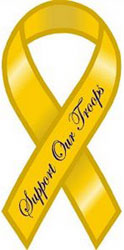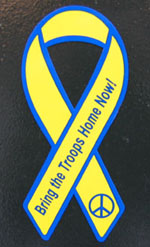colors
Orange vs Orange
Protesters against Israeli ‘disengagement’ from the West Bank and Gaza have taken to the streets flying orange ribbons in support of the settlers.
Only Palestinian groups protesting the occupation have been using orange ribbons for years.
Via Reuters, July 1, 2005:
“Israeli Arabs sue settlers over orange protests
An Arab party has asked an Israeli court to stop right-wing Jews using orange in protests against withdrawing from Gaza settlements, saying the colour was already theirs.
‘If we appear now in a march in the streets with orange, people will think we are settlers,’ said parliament member Azmi Bishara of the Arab Balad party, which is fundamentally opposed to settlements on Israeli-occupied land.
Orange, displayed on ribbons, flags and shirts, has emerged as a powerful pro-settler symbol in the run-up to the pullout. It is the municipal colour of the main Gush Katif Jewish settlement bloc in Gaza.
Bishara said his party has used an orange flag and logo since 1999, and launched the lawsuit after being flooded with calls from constituents.
The Balad party was concerned that use of the same colour by ultra-nationalist Jews would damage its image and confuse its anti-occupation message, he said.
It filed its suit in Haifa District Court on Thursday to prevent the Yesha settler council and other right-wing groups from using orange, saying the colour was now sending a ‘colonial, racist message’ that would make it difficult for Balad to continue using it.
‘You build an image. If you look at our logo you will see it is orange. Our flags are the same flags,’ Bishara said. ‘Real damage has been done.’
The Yesha council said it knew nothing of the suit.”
First their land, then their symbols. Oddly enough, this Haaretz article notes that while orange is the season’s hot color elsewhere in the world, it has become a fashion faux pas in Israel and Palestine.
The Wiphala
The Wiphala (from the Aymara word meaning “flag”) is a square shaped flag consisting of forty-nine small squares in a seven by seven grid, in the colors of the rainbow graduating from the brightest to the palest.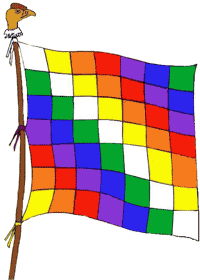
The flag is a symbol of the Aymara people, and recently, of the Aymara uprising in Bolivia. It has also become a symbol in the broader iconography of pro-indigenous movements in Ecuador, Peru, Bolivia, and Chile.
The origin of the design is uncertain. It is attributed the ancient Tiwanaku state. However, despite the indigenous aesthetic resonances of the unusual square pattern and multicolor geometry, it is most likely of modern origin. Although pre-Columbian towns of the Andes did not lack their own symbols (particularly those with a state tradition, like the Inca), the format of quadrilateral textile banner to wave in the wind is a tradition of the Old World.
Archaeological fragments from antiquity support the thesis that it may a “rescued” old symbol, as with the Chakana or Andean cross. It is possible that the modern origin of the Wiphala (without discarding the hypothesis of its Tiwanaku roots) is related to the design of modern flag of the Cusco (rectangular with seven horizontal strips with the colors of rainbow), which many claim to be a flag of the Incas.
Rainbow patterns were used in several symbols of the Tiwanaku state, but it is not documented in the form of a flag — while other formats of indigenous state symbols have been found.
 However, Aymara textile read as a symbol is not completely unheard of. In 1534, during the Spanish invasion and occupation of Cuzcu, the Spaniards found among the resistance a multitude of objects similar to the striped flag and and other iconography with the of seven colors of the rainbow. The Wiphala was banned, considered politically subversive by the governing elite.
However, Aymara textile read as a symbol is not completely unheard of. In 1534, during the Spanish invasion and occupation of Cuzcu, the Spaniards found among the resistance a multitude of objects similar to the striped flag and and other iconography with the of seven colors of the rainbow. The Wiphala was banned, considered politically subversive by the governing elite.
The great explosion in the use of the Wiphala coincides with the rural mobilizations and indigenous movements in Bolivia in the 1970’s. It has since become a recognizable Amerindian symbol in the political struggles of the indigenous nations of the American continent. In Bolivia, the Wiphala is visible in all kinds of public demonstrations, political actions, and civil resistance by the Aymara and Quechua population.
Civic use of the Wiphala in the daily life of indigenous communities has also grown enormously. It has become an Andean custom to hoist the flag at social and cultural events, ceremonies, and celebrations.
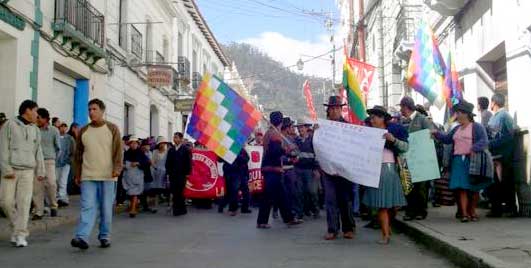
The Revloution Begins in Kyrgyzstan
Protestors are occupying government buildings, have taken over an airport, and set fire to a police station.
What Color are You?
Those political symbols, even for specific elections, don’t just rally the base — they reach far beyond their borders.
For instance, elections in Kyrgyzstan take place next month.
Kyrgyz Leaders Eye Ukraine Nervously, December 21, 2004:
“Speaking at a conference on democracy in Bishkek, [President Akayev] warned that no ‘colour’ revolutions would be permitted in Kyrgyzstan, referring to Georgia’s ‘rose revolution’ which brought down President Eduard Shevardnadze in November 2003, and the recent post-election turmoil in Ukraine, where Yuschenko supporters wore distinctive orange scarves.”
“Kyrgyz opposition responds to President Akayev’s warning of possible coup,” December 22, 2004, BBC Monitoring Central Asia:
“The united opposition in Kyrgyzstan denies the suggestion that it has ties to the West and does not believe that any revolutionary scenarios will be played out during the parliamentary election campaign. The deputies representing opposition parties and movements in Kyrgyzstan’s parliament even issued a lengthy statement to assure the public that they ‘do not applaud the events occurring in Ukraine’ and that they are not planning to organize a ‘tulip revolution’ in Kyrgyzstan, because ‘it could cause disparities in the country’s system of government’. Furthermore, the statement underscored the opposition’s intention to prevent any kind of outside intervention in the electoral process in Kyrgyzstan.”
KYRGYZINFO, January 13, 2005:
“President of Kyrgyzstan Askar Akaev urged the population of the republic to oppose the provocateurs and exporters of ‘velvet revolutions’. This was stated in his address to the people, to the parliament, to the government, to representatives of international organizations, to accredited diplomats and journalists.”
“Kyrgyz youth movement says no to ‘export of revolutions,’” January 18, 2005, BBC Monitoring Central Asia:
“The leader of the KelKel youth civil movement said: ‘Lemon is our symbol. We have chosen the lemon colour. We are against a party of the orange orange [Russian: oranzhevyy apelsin]. We are against the export of revolutions from abroad. We want to build our house on our own. We want to live in a sovereign and independent state.’”
Could this be the end of the one-color state?
Support Our Tropes
Those little yellow magnets seem to be everywhere. Not quite posters, it’s a regular grassroots movement of car signage, marking the public space in the bumper-to-bumper gaps between the private. (And what better place to support a war for oil?)
The NY Times has a brief story on the origins of the current magnet ribbon, while Design Observer digs up a broader history of the yellow ribbon symbol.
Since the civil war, the ribbon has been used to welcome home loved ones who had been away at war or in prison. The popular 1973 song was loosely based on the story of a soldier returning home from the Civil War. It was a number one hit in April 1973, at the height of the Vietnam War — a time when many veterans ambled to a less than friendly welcome.
But the meaning of the yellow ribbon has shifted over time. Do the current ribbons encourage support of those broken and maimed veterans showing up at homeless shelters? I presume not. I read the symbol as more than just a welcome home, but sign of “loyalty,” not just a show of concern for U.S. soldiers at war, but to admonish those who are not sufficiently supportive — for instance, who oppose the war.
Which is why I’m inclined towards the more specific version produced by United for Peace and Justice:
And the more oppositional styling of the duct tape version:
See also previous posts on freeway posters, orange, red, and blue ribbons.
Solidarity on Seventh Street

Spotted in the East Village, home of a Ukrainian diaspora community for over one hundred years.
Green or Black?
“Do you want green tea or black tea?”
In Uzbekistan, tea is the drink of hospitality. Community is all about hanging out in the choyhona (teahouse), talking and drinking tea while sitting on topchan, a kind of raised platform bed with a pad to sit on and a small table in the middle. (Thus, choyhona is also the name of a popular Internet chat network.)
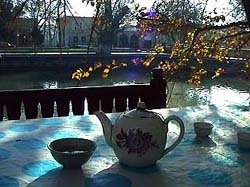 So which tea do you choose?1 The question seems simple, but the answer is fraught with political significance, identifying you as sympathetic to either ethnic Russians or ethnic Uzbeks.
So which tea do you choose?1 The question seems simple, but the answer is fraught with political significance, identifying you as sympathetic to either ethnic Russians or ethnic Uzbeks.
One of the legacies of the Soviet occupation in Central Asia is a population of ethnic Russians living there. Born in Central Asia and raised under Soviet culture, when the USSR fell and the borders rolled back, these ethnic Russians remained. This piece in Slate describes the predicament.
“Clara was a Soviet. Today, she must search for a new vocabulary to define her identity. She has no ties to the land of her ancestors and is neither Kazakh nor Russian.
This search for identity is mirrored in millions of ex-Soviet people of all ethnic groups. One of the more interesting cultural shifts in post-Soviet Central Asia is the status and identity of ethnic Russians. During Soviet rule, the Russians comprised more than half of the population in Kazakhstan, exiled by Stalin during the 1950s and ’60s mass migration under the ‘Virgin Lands’ campaign, when Russians were encouraged to cultivate northern Kazakhstan’s pastures.
So where does this leave ethnic Russians with no ties to the new but living in the place of their birth? Rootless.”
Ethnic Russians used to be identified with the power elite, but are no longer. Since Central Asian independence they are in some ways second-class citizens. Political leaders now promote a form of nationalism using ideas of ethnic authenticity — for instance, promoting local languages and literature supressed under Communism, or in the most extreme example, the President of Turkmenistan has banned all “non-Turkmen” cultural institutions.
In this climate, signs that might otherwise seem insignificant become significant cultural markers.
In Uzbekistan, conventional wisdom holds that Russians drink black tea and Uzbeks drink green tea. When with one group or another, drinking the appropriate tea identifies one as part of the “in group.” The sign, though, can be waved by anyone — an ethnic Russian among Uzbeks may choose green tea to signify that he or she is down with the group.
Ironically, the political leaders pushing the nationalism are often themselves the products of Soviet education and the Soviet system. They speak fluent Russian... and though they’d never admit it, might even prefer black tea.
1 Choosing neither will win you a stern lecture on the important health benefits of tea.
The Red Menace
Email from a friend in South Korea during the 2002 World Cup:
“The new national color of Korea is red. It used to be that red stands for communists in Korea and therefore, it’s a taboo color. We used to color communists in red in all the anti-North-Korean posters. When I was young, I even thought that communists had red faces. All of sudden, red became the color for Korean soccer, thanks to ‘Red Devil,’ the non-profit national soccer cheering association. The streets are filled with people wearing red T-shirts with ‘The Reds’ writing. I guess red is no longer a taboo.”
The Red Ribbon
“The Ribbon Project was created in 1991 by the Visual AIDS Artists Caucus, a group of artists who wished to create a visual symbol to demonstrate compassion for people living with AIDS and their caregivers. Inspired by the yellow ribbons honoring American soldiers serving in the Gulf war, the color red was chosen for its, ‘connection to blood and the idea of passion — not only anger, but love, like a valentine.’ First worn publicly by Jeremy Irons at the 1991 Tony Awards, the ribbon soon became renowned as an international symbol of AIDS awareness, becoming a politically correct fashion accessory on the lapels of celebrities. While this has caused concern to many activists, who worry that its meaning has become trivialized, as well as denigrated by the proliferation of ‘kitsch’ ribbon objects, the Red Ribbon continues to be a powerful force in the fight to increase public awareness of HIV/AIDS and in the lobbying efforts to increase funding for AIDS services and research.”
page 2 1


